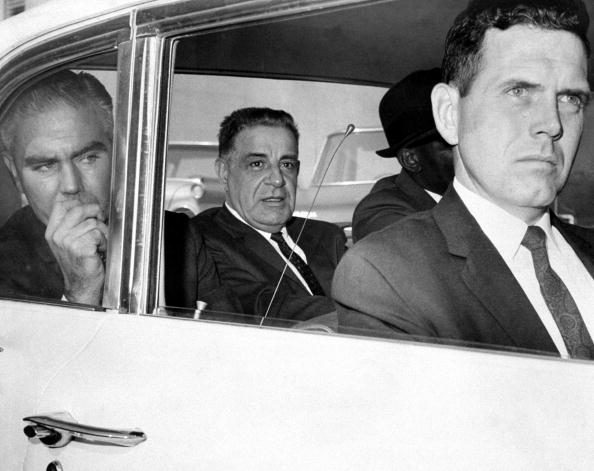When the state hides its criminal citizens

The United States has played a pioneering role in implementing witness protection. Set up in 1971, the federal WitSec programme has since moved on from organised crime to dealing with newer forms of criminality such as gangs or international terrorism.
Joseph Valachi died quietly in prison of a heart attack in 1971 at age 67. He had managed to avoid being killed despite a $100,000 bounty (up to $2.5 million – SFr2.3 million – in today’s currency) on his head for betraying the mafia.
Valachi, the first member of the mafia to publicly acknowledge its existence, had benefited from US government protection. When he testified before a Senate committee in 1963, he was escorted by 200 marshals. In jail, he was kept apart from other detainees and his only contacts were with FBI staff and prison officials.
His case led in 1971 to the creation of WitSec as part of the Organized Crime Control Act. It guarantees the security of people who collaborate with the authorities, who can be victims or bystanders.
But in 95 per cent of all cases, the witnesses are criminals according to a 2010 Rutgers University study. They usually accept to describe the internal setup of their organisation and testify against their former colleagues in exchange for lightened sentences.
They are given protection during any trials and in prison.
“There are seven Protective Custody Units, with the capacity to house approximately 100 witnesses under protection,” explained Jack Donson, a lecturer in criminal justice at Marywood University.
“They go by initials, not names, have an individual cell and get polygraphs [lie-detector tests] to make sure they are not trying to gain access to the units to kill another witness.”
Since its creation in 1971, WitSec has helped a total of 18,400 people: 8,500 witnesses and their 9,900 family members. This averages out at 438 people per year, when only around 30 were expected.
This has led to a regular increase of the number of people protected by WitSec, passing for example from over 15,000 in 1995 to more than 17,000 in 2003. During that time, around 500 were incarcerated.
The information supplied by these witnesses led to the convictions of around 10,000 criminals, with successful prosecution in 89 per cent of cases. No witnesses staying under programme has been killed or hurt until now.
New identity
After completing their sentence, they are given a new identity, including a professional past and medical record, and relocated in another town.
“They get to pick between three places, usually small isolated towns or suburban areas,” said Donson. “But some people can be harder to hide, like gang members covered in tattoos or members of the mafia with strong New York accents.”
They can take their children or wife with them, but that’s all. “They can’t have any contact at all, ever, with former friends or relatives,” pointed out Gerald Shargel, a New York defence attorney who took part in several cases involving members of the mafia.
Participants in the witness protection programme are also given financial support for the first few years, around $60,000 per year, as well as help in finding a job. If necessary, they can also have psychological support.

More
Witness programme to break code of silence
“Social death”
This “social death” weighs heavily. “A lot of witnesses find that completely separating themselves from their former lives and starting over is a very difficult experience,” said Alan Vinegrad, a lawyer and a former prosecutor for the Eastern District of New York.
Witnesses under protection often have to give up any hope of a career. As a 2008 report published by the United Nations Office on Drugs and Crime (UNODC) highlighted, people from liberal professions often have to accept to become unqualified workers.
“Some people feel that it isn’t worth it and give up on the program. But they rarely survive once they go back to their communities,” said UNODC witness protection adviser Gerhard Van Rooyen. Around 30 people have been murdered after leaving WitSec for example.
Another concern is the threat some participants can be in the new environment. “People tend to return to what they know. Someone who has been a criminal his whole life will go back into crime,” added Shargel.
Brenda Paz, born in Honduras, was 12 when she joined the MS-13 gang in the Washington region. At age 17, she was arrested and immediately began to provide details of a long list of murders and armed attacks carried out by gang members, including her own boyfriend.
Her former gang colleagues found out quickly she had turned them in and put a price on her head. Paz joined the protection programme in March 2003. Given a new name, she was relocated to Kansas City. But she soon got back in touch with her old gang.
In June, gang members convinced her to return, stating that all was forgiven. Her body was found shortly after by a fisherman in Virginia’s Shenandoah River. She was 17 weeks pregnant and had been stabbed 19 times.
Turning bad
The Marion Pruett case is one example of a witness turning bad. Pruett, locked away for a holdup, was freed with a new identity and relocated to New Mexico in 1978 after accepting to testify about a murder committed by a fellow detainee.
Once on the outside, he went on a killing spree that left eight people dead, including his wife.
New York mafioso Sammy Gravano, was another bad apple. Relocated in 1995 to Arizona with his family, he was arrested in 2000 for dealing ecstasy.
Despite these well publicised cases, this is not as big an issue as it might seem. “The recidivism rate for people involved in the witness programme is 17 per cent, which is much lower than that of criminals who are released on parole [40 per cent],” Vinegrad told swissinfo.ch.
The WitSec programme was launched in the 1970s to break the code of silence surrounding the Italian mafia, seen then as the biggest criminal threat. Since then it has been used against other types of criminals.
In the 1980s, it focused on collecting information about the drug cartels, and since the 1990s, on slowing the expansion of gangs in American cities. The September 11, 2001 attacks also led to its use against terrorist groups.
This has complicated the work of justice officials, as Donson points out. “Members of traditional Italian crime are more manageable: they follow a code of honor and keep business within the family,” he said. “Gang members are less disciplined, have more trouble following rules and sometimes have drug issues.”
Terrorism
Witnesses in terrorism cases tend to be foreigners, leading to other issues.
“They need to obtain legal US residency to be included in the programme,” said Tarik Abdel-Monem, a researcher at Nebraska University .”But there is a lack of cooperation between the Department of Justice and the immigration authorities. Promises are made and not honoured.”
Abdel-Monem says the case of Adnan Awad is just one example. Awad, a Palestinian, collaborated with the Swiss authorities after deciding not to lay a bomb at Geneva’s Hilton hotel.
“He was promised a US passport but never received it,” added Abdel-Monem.
Broken promises are not the only problem faced by the witness programme. The emergence of internet has also had an impact. “Social media networks and online databases have made it so much easier to trace someone on the internet,” said Van Rooyen.
(Translated from French by Scott Capper)

In compliance with the JTI standards
More: SWI swissinfo.ch certified by the Journalism Trust Initiative
You can find an overview of ongoing debates with our journalists here. Please join us!
If you want to start a conversation about a topic raised in this article or want to report factual errors, email us at english@swissinfo.ch.